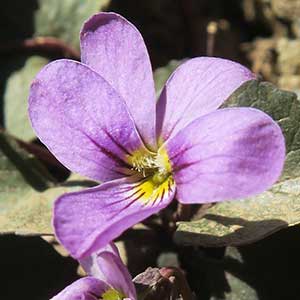Viola flettii
Viola tripartita
Flett's violet, Olympic violet, rock violet
three-part or Piedmont or threepart violet, threepart violet
1–3, ascending to erect, mostly glabrous, on caudex from fleshy rhizome.
1(2), erect, leafless proximally, leafy distally, glabrous or puberulent, from subligneous rhizome.
basal and cauline;
basal: 1–3;
stipules linear-lanceolate, margins entire or with glandular processes, apex acuminate;
petiole 1.5–9.7 cm, mostly glabrous;
blade purple-tinted and –veined, broadly reniform to ovate, 0.9–2.4 × 1.2–4 cm, base cordate, margins finely crenate-serrate, eciliate, apex acute to obtuse, surfaces glabrous or sparsely pubescent along veins adaxially;
cauline similar to basal except: stipules ovate to lanceolate, margins entire or shallowly laciniate;
petiole 0.7–5.9 cm, usually glabrous;
blade 0.8–2.1 × 1.2–3.1 cm.
basal and cauline;
basal: 0(–2);
stipules ovate, not leaflike, margins entire, apex acute to acuminate, surfaces glabrous or puberulent;
petiole 9–11.5 cm, glabrous or puberulent;
blade unlobed, ovate, or 3–5-lobed, 4–5 × 1–5 cm, base cordate, margins entire or crenate-serrate, ciliate or eciliate, apex acute, surfaces glabrous or ± puberulent;
cauline similar to basal except: restricted to distal ends of stems;
stipules ovate to oblong;
petiole 0.7–7.2 cm, glabrous or puberulent;
blade unlobed, ovate or deltate, or 3-lobed (if 3-lobed, lateral lobes falcate, middle rhombic, longer than others, lobes may appear petiolate; unlobed and 3-lobed leaves can occur on same plant), 1–6 × 0.5–5.5 cm, base truncate to cuneate, margins serrate, ciliate or eciliate, surfaces glabrous or pubescent.
1.8–7.1 cm, usually glabrous.
1.5–4 cm, glabrous or pubescent.
sepals lanceolate, margins eciliate, auricles 0.5–1.5 mm;
petals soft reddish violet on both surfaces, all with yellow area basally, lower 3 dark violet-veined, lateral 2 bearded, lowest with white around yellow area, 10–15 mm, spur yellow, gibbous, 0.5–2 mm;
style head bearded; cleistogamous flowers axillary.
sepals lanceolate to ovate, margins ciliate or eciliate, auricles 0.1–0.5 mm;
petals lemon-yellow adaxially, upper 2, rarely others, brownish purple abaxially, lowest and usually lateral 2 brownish purple-veined, lateral 2 and sometimes lowest bearded, lowest 10–18 mm, spur yellow, gibbous, 0.5–2 mm;
style head bearded; cleistogamous flowers axillary.
± spherical, 5–9 mm, glabrous.
ovoid to ellipsoid, 9–12 mm, glabrous.
dark brown to brownish purple, 2.5–3 mm.
beige, bronze, or brown, 2.4–3 mm.
= 12.
Viola flettii
Viola tripartita
Viola flettii is endemic to the Olympic Mountains of northwestern Washington. C. S. McCreary (2005) noted that although morphologically and ecologically distinct, V. cuneata, V. flettii, and V. ocellata are closely related.
(Discussion copyrighted by Flora of North America; reprinted with permission.)
Some authors recognize two varieties of Viola tripartita based on lobed versus unlobed leaves. F. L. Lévesque and P. M. Dansereau (1966) suggested that leaf variation is the only character difference between vars. tripartita and glaberrima. N. H. Russell (1965) stated that V. tripartita plants with lobed and unlobed leaves are sympatric and frequently intergrade and did not recognize them as distinct. The situation with two leaf forms in V. tripartita is similar to V. lobata, which also has two leaf forms.
(Discussion copyrighted by Flora of North America; reprinted with permission.)


